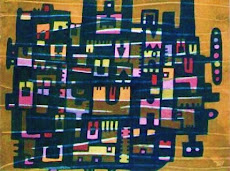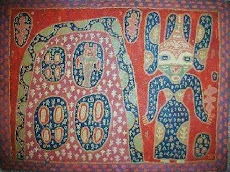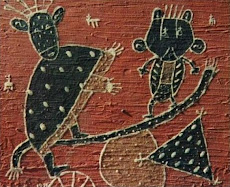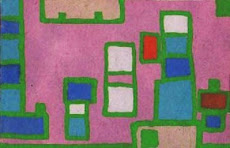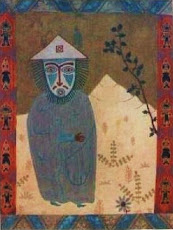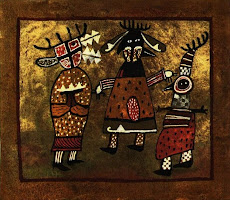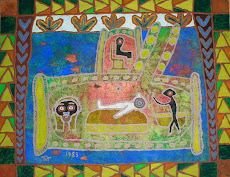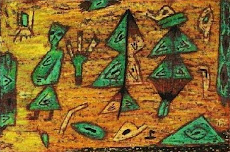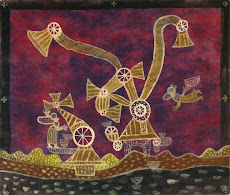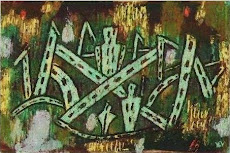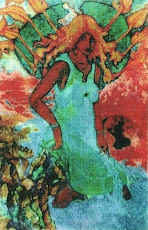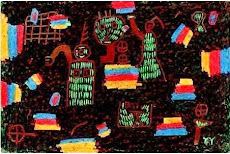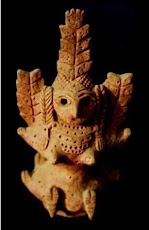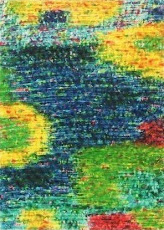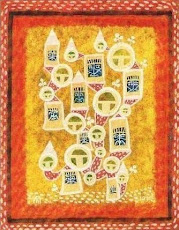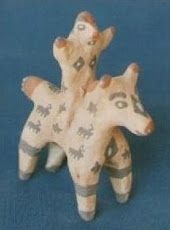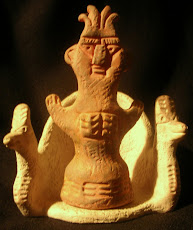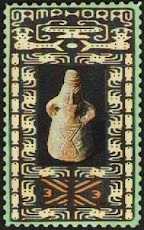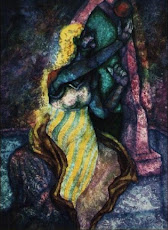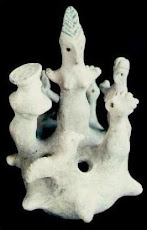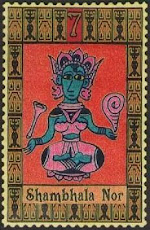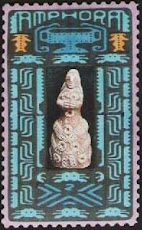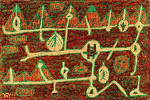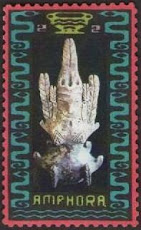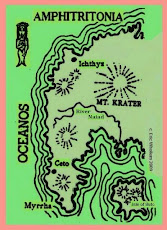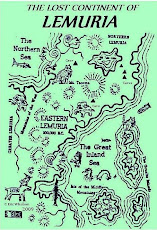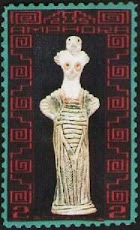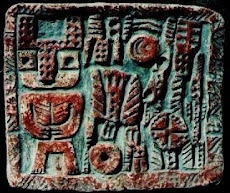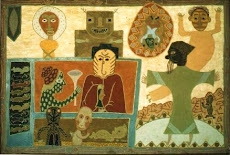Makari
THE JESSAMINE ISLE
2010
by Eric Whollem
COPYRIGHT BY THE ARTIST
CLICK ON IMAGE TO ENLARGE
The Queen of the Starfish
The stamps on this blog post are from the fantasy realm of the
Jessamine Isle.
Makari is the Queen of the Jessamine Isle~known as the Queen of the
Starfish. Her name is based on lore from various cultures. In Polynesia
Makarii is the name of the constellation of the Pleaides.
The mythographic lore that follows gives a more in depth account of
how the Makarii got their name. Most of the data evaluated here is
adopted from my book, 'The Mystery of the Mermaids: Goddesses and
Gods of the Sea.'
The name 'Makari' is a fictional designation~used here for my own
artistic purposes; but she is rooted in my studies of the lore of the
mystic East.
MAKARI and the Mysteries of the Mermaids
by Eric Whollem
Makari, the Consort of the Sea God
Makari is hypothetically the female aspect of Makara, the God
of the Sea in both the Hindu and Buddhist traditions. Makara is usually
described in terms of the Svadisthana Chakra, or second chakra,
which rules creativity and vital impulses. Makari, as I describe her,
might well be correlated to Mahakali, who is a Goddess of passions.
Makari is my own neoteric designation of an important aspect of the Sea
Goddess. Her male aspect, Makara, however, is well established in
mythological and ethnographic texts.
MAKARA
Makara is sometimes depicted as a chimaerical animal which
blends various creatures into one. In this Makara typifies
Imagination. Sometimes this chimaera is identified with the
dolphin. The dolphin is 'delphys' in Greek and refers to the womb.
The chimaera has often been interpreted as a mythic representation
of phylogenesis. Seemingly the embryo goes through recapitulations
of evolutionary stages in it's development in the womb.
There are river dolphins in India. Makara is sometimes identified
with the Gangetic Dolphin, though some read the iconography of'
the elephant and the crocodile into it's image. The crocodile is an
old Hindu metaphor for the sensual impulse. One can find a variety
of images of Makara on Wikipedia~on the link provided in this post.
In ancient Egypt Horus, the hawk, was said to reside in the buttocks,
yet rise to the eye of Ra, the third eye. He was called the fish of Kamui,
who was conceived of as part crocodile. Sebek is the sacred crocodile
of the Nile. (In the section below, entitled 'The Mythic Lore of the Dolphin,
I show how Kamui may be related to the Kaiaimunu of New Guinea.)
Many observers of archaic Egyptian lore have noted that Egypt was
the original home of concepts that lead to what appeared much later
in India as Kundalini Yoga. The buttocks mentioned above correlate
to the Muladhara Chakra, and the eye of Ra to the Ajna Chakra, which
will be familiar to students of yoga.
THE PLEIADES
In Polynesia the Pleiades are called the Makarii. They were
conceived of as seven sisters.
In India the Pleiades were varyingly called the Karttikeyani or
the Kaumari. Kauri is a pre-Vedic word for the cowrie. The
cowrie is regarded in many cultures of the world as a symbol
of the yoni. The Kaumaris were passional divinities. The male
aspect of the Kaumaris were the Kumaras.
One might speculate as to whether the Goddess Kali's name
is derived from 'Kaurie.' The widely diffused respect given to
the cowrie as a symbol of the Divine Feminine is well known.
Many elements from Hinduism can be discerned in the Kaula
shamanistic system of the Polynesians. This is not totally far
afield as many ethnologists speculate that the Polynesian
migrations may have arisen from Southeast Asia where
Hinduism was widespread. For example, Mano, the shark, who
guided the canoe of the Hawaiians, correlates to Manu, who
lead the boat of the Hindu Noah.
In my book, 'The Mystery of the Mermaids,' I go into depth
showing the links between the Kaulas of India and the Kaulas
of Hawaii.
Helene Blavatsky once noted that Makara as found in Kundalini
Yoga can be interpreted as a shark.
MYTHIC LORE OF THE DOLPHIN
Interestingly enough, in New Guinea, there is an intiatory wicker
construction called the Kaiaimunu, which appears to have a long
toothy snout similar to old renditions of Makara in India. But the
long beak is also very dophin-like. The rites of Delphi in Greece
are named for the dolphins that swim the river near Mt. Olympus.
The Eleusinian Mysteries, centered in Delphi, were an important
initiatory system, well known today.
The Kaiaimunu gives us a strange ethnographic correlation to the
Greek and Hindu lore outlined above. Kundalini Yoga is decidedly
a yogic system where initiation is paramount, as the practices are
involved and require expert guidance. It is not impossible that
initiatory rites from India diffused along the sea lanes to New Guinea,
as Indonesia nearby had a long history of Hinduism, which only
remains today on the lone isle of Bali where it is praticed today.
In the Neareast the ancient Phoenicians were worshippers of Dagon;
this merman god had an initiatory system that involved the initiate
being encloistered in the belly of a huge statue of Dagon. This
cell was called 'The Belly of the Whale.' After three days of visions
in the darkness, the initiate was said to have reached enlightenment.
In New Guinea the intiates were similarly placed in the belly of the wicker
Kaiaimunu.
The wife of Dagon was Atargatis, whose name means Starwhale. She
corresponds to the mother of Ea, Derceto, the Whale Mother from
Mesopotamian mythology. Ea was anciently depicted as a goat with
a fish's tail and was the sign of Capricorn in astrology. In Chinese
astrology Capricorn is the dolphin.
In Kundalini Yoga, Makara rises ultimately to the third eye, where
as Bindu it resonates with the sound of AUM, the primordial cosmic
vibration. Read Arthur Avalon's book, 'The Serpent Fire' for a more
comprehensive overview of these particulars.
MAKARA IN BUDDHISM
In Buddhism Makara is the Sea King. In the Lankavatara Sutra Buddha
is said to have preached to Makara in his abode under the sea for a
period of seven days, wherein he left the Prajnaparamita teachings with
the denizens of the subaquatic domain. Tara rose from the waters
hundreds of years later to profer these Goddess Teachings to the sage
Nagarjuna. These teachings are the basis of Mahayana Buddhism.
The great Tibetan sage Padmakara, whose name means five-fold lotus,
had as his consort Vast Ocean, or Jnanasagara. His name also could be
read as 'foot of the Sea King.' The Vajrayana view is that the King of the
Nagas (or sea serpents) is the sprout from which the heavenly oceanic
illumination arises.
The Nagas are the merpeople respected in Hindu mythology as the
aquatic demigods. Usually they are shown with serpent tails rather
than fish fins like the mermaids of many cultures. The Gopis that
swam the river with Krishna were such Naginis, or female Nagas.
OTHER HINDU SEA GODDESSES
Makara also appears in the Hindu Puranas where he is said to have
held the Earth Goddess Bhu captive under the sea.
There are many sea Goddesses in Hinduism: Varuni, Sri, Sagara, etc.
Mahakali (or my designation, Makari) as the counterpart of Makara
could perhaps be construed as the correlation of the Greek Amphitrite,
the dolphin bride of Poseidon. She could also be compared to Atargatis,
the dolphin mermaid Goddess of the Neareast. The closest divinity to Makari ,
aside from Mahakali, that is named in Hindu lore is Marishi, the water Rishi,
who is featured in the Puranas.
Sisumara, the constellation of the north in Hinduism, is a sacred porpoise.
The north star is important in Hinduism as the source of the Race of Dhruva,
who now populate the earth as humanity.
Sri is famous as the primordial Goddess who arose from the Milk Ocean
at the beginning of Creation. She is often described as the consort of
Brahma, the Creator God.
In the Rig Veda, Varuna, is one of the ancient Sea Gods of India. His
eye is said to be the Sun. Varuni is his bride; she is said to be a Goddess
of wine. In this perhaps the Hindus and the Greeks poetically agree on the
the metaphor of wine for the sea.
See this link for a bit more information on Makara:
See also:
Read more about ATARGATIS on my post:
Makari
Stamps from the Jessamine Isle
Makari
THE JESSAMINE ISLE
2010
by Eric Whollem
COPYRIGHT BY THE ARTIST
CLICK ON IMAGE TO ENLARGE
Faux Postage Stamps
Eric Whollem
2010
Makari
THE JESSAMINE ISLE
2010
by Eric Whollem
COPYRIGHT BY THE ARTIST
CLICK ON IMAGE TO ENLARGE
Makari the Queen of Starfish
ON THE CINDERELLA STAMPS OF THE JESSAMINE ISLE
In the faux postage stamps shown above from my fantasy
mermaid micronation of the Jessamine Isle, Makari is posited
as the Queen of Starfish.
In the symbolism outlined above an astute observer might note
that she might well be construed as a Pleaidian Goddess, related to
the Makarii of the Polynesians.
Makara means 'fifth finger' in Sanskrit, and relates to the thumb.
But estoterically Makara in rising to the third eye in the arousal
of the Kundalini engergy becomes a star at the Bindu point between
the brows.
Thus Makari could be symbolized as the starfish, a five-pointed
starry being. In the mythology of the Jessamine Isle this is indeed the
case, as Makari is the ruler and Goddess of the Starfishes. In ancient
esoteric lore of initiation Five is an all-important number. It is a chief
symbol of initiation. And in alchemy the search for the Quintessence,
or Fifth Element, was a major aspect of the Magnum Opus, or Great
Work.
Thus the mermaids of the Jessamine Isle are well read in alchemical
texts, and revere the Starfish as a divinity of high estate. . . a noble
symbol of the Quintessence.
Video by Eric Whollem, 2011
MORE MERMAID ART
________________
See more of my stamps from THE JESSAMINE ISLE on this link:
My posts on the topic of the GODDESS may be found here:
Readers interested in my posts on MYTHOLOGY might want to see:
Those with an interest MERMAIDS should view:
Posts on ALCHEMY can be accessed on this link:
*
Artist Stamps
Artistamps, cinderella stamps, cyberstamps,
fantasy stamps, faux postage,
mail art, micronation stamps,
virtual stamps; digital art.
*




















